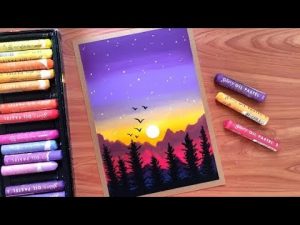Ever fancied yourself a budding artist, only to retreat at the sight of those bewildering pastel sticks? Don’t fret. You’re not alone in this colorful conundrum. The world of pastel art class often feels more like a delightful treasure hunt—with a sprinkle of chaos and a dash of magic dust.

Starting with pastels is not about creating masterpieces on your first try. It’s about diving headfirst into the sea of colors, like a kid who’s just discovered a box of crayons. Remember when you were a child and didn’t care about drawing the “perfect” picture? That’s the spirit! Embrace the mess and the mayhem. Let creativity fuel your exploration.
Pastels, a musky blend of pigment and binder, have a history that stretches back to the Renaissance. Imagine the likes of Leonardo da Vinci or Edgar Degas using them, coming to life in a swirl of hues. Today, we follow in their colorful footsteps, tapping into that timeless magic.
When starting a course, don’t stress about technique at first. Think of it like learning to ride a bike. You’re bound to wobble and fall initially, but soon you’ll find your balance. Pastel painting is largely about the tactile experience—smudging, blending, and feeling the texture of pigments beneath your fingertips. It’s an odyssey, one where the process is just as rewarding as the final product.
Let’s talk blending. This is where things start to get spicy. You’ll find yourself experimenting, mixing vibrant blues with soft yellows, creating dazzling greens like an alchemist. And keeping clean hands isn’t just about hygiene here, it’s about not inadvertently dragging yesterday’s masterpiece into today’s creation.
Choosing colors can feel like standing before a vast ocean, with every shade more tantalizing than the last. Start with a simple palette. It’s much like a chef starting with basic ingredients and creating a culinary masterpiece. You discover depth not in the number of colors, but in how you wield them.
The paper is your stage. Each texture carries its own personality. A coarser paper grips more pastel, ready to shout your colors from the rooftops, while a smooth surface offers subtle whispers instead. It’s all about trying different papers and discovering which tickles your fancy. Imagine each surface as a different voice in a choir, each contributing its unique song to your visual symphony.
Feedback is your north star, guiding you through uncharted waters. It’s easy to get wrapped up in your own perspective, so let others be your compass. Join discussions, attend workshops, and don’t be afraid to wear your heart on your sleeve. A little constructive criticism is like a pat on the back from a friend who knows your potential.
Don’t be afraid of mistakes. They’re the seasoning of the artistic journey. Layers in pastel painting are forgiving—as forgiving as a mother seeing the messy cake her child baked. Such blunders often become the most striking parts of your piece. Turn that smear into abstract expression, borrowing a little wisdom and chuckling along the way.
Sharing your art, your trials, and your triumphs with others is like exchanging stories around a campfire. Engage with your fellow artists. Swap tips, laugh at mishaps, and perhaps indulge in a debate about whether chocolate or strawberry ice cream inspires the most creativity.
All in all, a pastel painting course is an adventure of finding your voice in color. It’s about letting those vibrant strokes whisper—or perhaps shout—your artistic soul to the world. With time, patience, and a touch of your unique flair, your work will evolve into something as mesmerizing as witnessing a symphony of colors dancing across the sky at dusk.